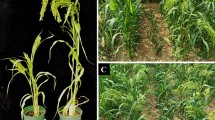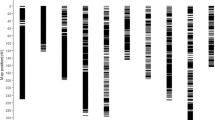Abstract
Gloeostereum incarnatum is an edible medicinal mushroom widely grown in China. Using the whole genome of G. incarnatum, simple sequence repeat (SSR) markers were developed and synthetic primers were designed to construct its first genetic linkage map. The 1,048.6 cm map is composed of 10 linkage groups and contains 183 SSR markers. In total, 112 genome assembly sequences were anchored, representing 16.43 Mb and covering 46.41% of the genome. Selfing populations were used for quantitative trait loci (QTL) targeting, and the composite interval mapping method was used to co-localize the mycelium growth rate (potato dextrose agar and sawdust), growth period, yield and fruiting body length, and width and thickness. The 14 QTLs of agronomic traits had LOD values of 3.20–6.51 and contribution rates of 2.22–13.18%. No linkage relationship was found between the mycelium growth rate and the growth period, but a linkage relationship was observed among the length, width and thickness of the fruiting bodies. Using NCBI’s BLAST alignment, the genomic sequences corresponding to the QTL regions were compared, and a TPR-like protein candidate gene was selected. Using whole-genome data, 138 candidate genes were found in four sequence fragments of two SSR markers located in the same scaffold. The genetic map and QTLs established in this study will aid in developing selective markers for agronomic traits and identifying corresponding genes, thereby providing a scientific basis for the further gene mapping of quantitative traits and the marker-assisted selection of functional genes in G. incarnatum breeding programs.
Similar content being viewed by others
References
Cabello, J.V., Giacomelli, J.I., Piattoni, C.V., Iglesias, A.A., and Chan, R.L. 2016. The sunflower transcription factor HaHB11 improves yield, biomass and tolerance to flooding in transgenic Arabidopsis plants. J. Biotechnol. 222, 73–83.
Chen, J. 2008. Master’s thesis. Nanjing Medical University, Jiangsu, Nanjing, P. R. China.
Coello, P., Hoy, S.J., and Halfold, N.G. 2010. The sucrose non-fermenting-1-related (SnRK) family of protein kinases: potential for manipulation to improve stress tolerance and increase yield. J. Exp. Bot. 62, 883–893.
Dutech, C., Enjalbert, J., Fournier, E., Delmontte, F., Barrés, B., Carlier, J., Tharreau, D., and Giraud, T. 2007. Challenges of microsatellite isolation in fungi. Fungal Genet. Biol. 44, 933–949.
Ferreira, S.S., Hotta, C., Poelking, V.G.C., Leite, D.C.C., Buckeridge, M.S., Loureiro, M.E., Barbosa, M.H.P., Carneiro, M.S., and Souza, G. 2016. Co-expression network analysis reveals transcription factors associated to cell wall biosynthesis in sugarcane. Plant Mol. Biol. 91, 15–35.
Foulongne-Oriol, M. 2012. Genetic linkage mapping in fungi: current state, applications, and future trends. Appl. Microbiol. Biotechnol. 95, 891–904.
Foulongne-Oriol, M., Rocha de Brito, M., Cabannes, D., Clément, A., Spataro, C., Moinard, M., Souza Dias, E., Callac, P., and Savoie, J.M. 2016. The genetic linkage map of the medicinal mushroom Agaricus subrufescens reveals highly conserved macrosynteny with the congeneric species Agaricus bisporus. G3 6, 1217–1226.
Foulongne-Oriol, M., Spataro, C., Cathalot, V., Monllor, S., and Savoie, J.M. 2010. An expanded genetic linkage map of an inter-varietal Agaricus bisporus var. bisporus × A. bisporus var. burnettii hybrid based on AFLP, SSR and CAPS markers sheds light on the recombination behaviour of the species. Fungal Genet. Biol. 47, 226–236.
Gong, W.B. 2014. Master’s thesis. Huazhong Agricultural University, Hubei, Wuhan, P. R. China.
Gong, W.B., Liu, W., Lu, Y.Y., Bian, Y.B., Zhou, Y., Kwan, H.S., Cheung, M.K., and Xiao, Y. 2014a. Constructing a new integrated genetic linkage map and mapping quantitative trait loci for vegetative mycelium growth rate in Lentinula edodes. Fungal Biol. 118, 295–308.
Gong, W.B., Xu, R., Xiao, Y., Zhou, Y., and Bian, Y. 2014b. Phenotypic evaluation and analysis of important agronomic traits in the hybrid and natural populations of Lentinula edode. Sci. Hortic. 179, 271–276.
Im, C.H., Park, Y.H., Hammel, K.E., Park, B., Kwon, S.W., Ryu, H., and Ryu, J.S. 2016. Construction of a genetic linkage map and analysis of quantitative trait loci associated with the agronomically important traits of Pleurotus eryngii. Fungal Genet. Biol. 92, 50–64.
Kiyama, R., Furutani, Y., Kawaguchi, K., and Nakanishi, T. 2018. Genome sequence of the cauliflower mushroom Sparassis crispa (Hanabiratake) and its association with beneficial usage. Sci. Rep. 8, 16053.
Labbé, J., Zhang, X., Yin, T., Schmutz, J., Grimwood, J., Martin, F., and Tacon, F.L. 2008. A genetic linkage map for the ectomycorrhizal fungus Laccaria bicolor and its alignment to the wholegenome sequence assemblies. New Phytologist 180, 316–328.
Larraya, L.M., Alfonso, M., Pisabarro, A.G., and Ramírez, L. 2003. Mapping of genomic regions (quantitative trait loci) controlling production and quality in industrial cultures of the edible basidiomycete Pleurotus ostreatus. Appl. Environ. Microbiol. 69, 3617–3625.
Larraya, L.M., Idareta, E., Arana, D., Ritter, E., Pisabarro, A.G., and Ramírez, L. 2002. Quantitative trait loci controlling vegetative growth rate in the edible basidiomycete Pleurotus ostreatus. Appl. Environ. Microbiol. 68, 1109–1114.
Li, Y., Li, T.H., Yang, Z.L., Dai, Y.C., and Tolgor, B., 2015. China’s large-scale microbial resources map. Zhongyuan Peasant Press, Zhengzhou, P. R. China.
Li, H.M., Shang, X.D., Tan, Q., Pan, Y.J., and Chen, M.J. 2009. Genetic differentiation of self-crossing S1 generations of Pleurotus eryngii. Mycosystema 28, 541–547.
Liu, G.J. 2011. Master’s thesis. Jilin Agricultural University, Jilin, Changchun, P. R. China.
Lu, L.X., Liu, H.Y., Yao, F.J., Fang, M., Zhang, Y.M., Wang, P., and Zhang, W.T. 2017a. Research progress of genetic linkage map on the edible fungi. J. Fungal Res. 2, 140–143.
Lu, L.X., Yao, F.J., Wang, P., Fang, M., Zhang, Y.M., Zhang, W.T., Kong, X.H., and Lu, J. 2017b. Construction of a genetic linkage map and QTL mapping of agronomic traits in Auricularia auricula-judae. J. Microbiol. 55, 792–799.
Murray, M.G. and Thompson, W.F. 1980. Rapid isolation of high molecular weight plant DNA. Nucleic Acids Res. 8, 4321–4326.
Ren, Y., Zhao, H., Kou, Q., Jiang, J., Guo, S.G., Zhang, H., Hou, W., Zou, X., Sun, H., Gong, G., et al. 2012. A high resolution genetic map anchoring scaffolds of the sequenced watermelon genome. PLoS ONE 7, e29453.
Salmones, D., Gaitán-Hernández, R., Pérez, R., and Guzmán, G. 1997. Studies on genus Pleurotus. VIII. Interaction between mycelial growth and yield. Rev. Iberoam. Micol. 14, 173–176.
Song, H. 2008. Master’s thesis. Jilin Agricultural University, Jilin, Changchun, P. R. China.
Song, H., Yao, F.J., Tang, J., and Nie, L.L. 2008. Research overview of Gloeostereum incarnatum. Edible Fungi of China 27, 3–4, 13.
Sun, L.D. 2013. Master’s thesis. Beijing Forestry University, Beijing, P. R. China.
Van Ooijen, J.W. 2006. JoinMap 4.0: Software for the calculation of genetic linkage maps in experimental populations. Kyazma B.V., Wageningen, Netherlands.
Wang, Y. 2011. Master’s thesis. Beijing Academy of Agricultural Sciences, Beijing, P. R. China.
Wang, S., Basten, C.J., and Zeng, Z.B. 2012. Windows QTL cartographer 2.5. Department of Statistics, North Carolina State University, Raleigh, North Carolina, USA.
Wang, P., Yao, F.J., Lu, L.X., Fang, M., Zhang, Y.M., Khan, A.A., Kong, X.H., Yu, J., Jiang, W.Z., Kitamoto, Y., et al. 2019. Map-based cloning of genes encoding key enzymes for pigment synthesis in Auricularia cornea. Fungal Biol. 123, 843–853.
Xiang, X., Li, C., Li, L., Bian, Y., Kwan, H.S., Nong, W., Cheung, M.K., and Xiao, Y. 2016. Genetic diversity and population structure of Chinese Lentinula edodes revealed by InDel and SSR markers. Mycol. Progress 15, 37.
Xie, B.G., Jiang, Y.J., and Wu, W.L. 2004. Fruit-body color inheritance of Flammulina velutipes. Mycosystema 23, 79–84.
Xiong, D.K. 2014. Master’s thesis. Huazhong Agricultural University, Hubei, Wuhan, P. R. China.
Yu, Y. 2013. Master’s thesis. Jilin Agricultural University, Jilin, Changchun, P. R. China.
Yu, Y. 2016. Master’s thesis. Jilin Agricultural University, Jilin, Changchun, P. R. China.
Yu, Y., Yao, F.J., Sun, M.L., and Zhang, A.Q. 2013a. Spring and Autumn cultivation management technology of Gloeostereum incarnatum. Northern Hortic. 10, 145–146.
Yu, Y., Yao, F.J., Sun, M.L., Zhang, Y.M., and Hu, X. 2013b. A new Gloeostereum incarnatum cultivar ‘Qirou 1’. Acta Hortic. Sinica 40, 1015–1016.
Yu, Y., Yao, F.J., and Zhang, Y.M. 2016. A new Gloeostereum incarnatum cultivar ‘Jirou 1’. Acta Hortic. Sinica 43, 1013–1014.
Zeng, Z.B. 1994. Precision mapping of quantitative trait loci. Genetics 136, 1457–1468.
Zhang, R.Y., Hu, D.D., Zuo, X., and Hu, Q.X. 2010. Strategies to develop SSR markers in edible mushrooms: a review. J. Fungal Res. 8, 239–244.
Zhang, Z.F., Lv, G.Y., Jiang, X., Chen, J.H., and Fan, L.F. 2015. Extraction optimization and biological properties of a polysaccharide isolated from Gleoestereum incarnatum. Carbohydr. Polym. 117, 185–191.
Acknowledgments
We thank Lesley Benyon, PhD, from Liwen Bianji, Edanz Group China (www.liwenbianji.cn/ac), for editing the English text of a draft of this manuscript.
This work was funded by the Guizhou Key Laboratory of Edible fungi breeding (No.[2019]5105-2004) and Higher Education Discipline Innovation Project (D17014).
Author information
Authors and Affiliations
Corresponding author
Additional information
Conflict of Interest
The authors declare that they have no conflicts of interests.
Electronic Supplementary Material
Rights and permissions
About this article
Cite this article
Jiang, WZ., Yao, FJ., Lu, LX. et al. Genetic linkage map construction and quantitative trait loci mapping of agronomic traits in Gloeostereum incarnatum. J Microbiol. 59, 41–50 (2021). https://doi.org/10.1007/s12275-021-0242-5
Received:
Revised:
Accepted:
Published:
Issue Date:
DOI: https://doi.org/10.1007/s12275-021-0242-5




